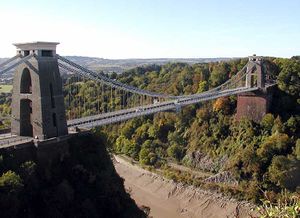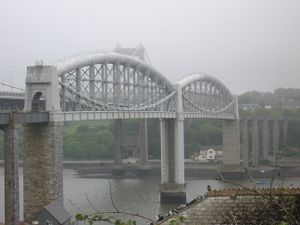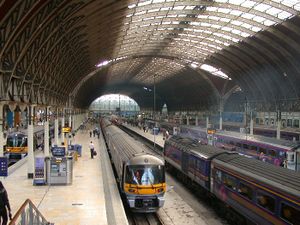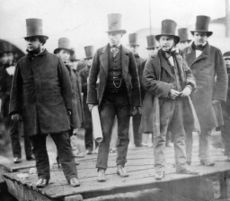إيزمبارد كنجدم برونل
إيزمبارد كنگدم برونل | |
|---|---|
Isambard Kingdom Brunel | |
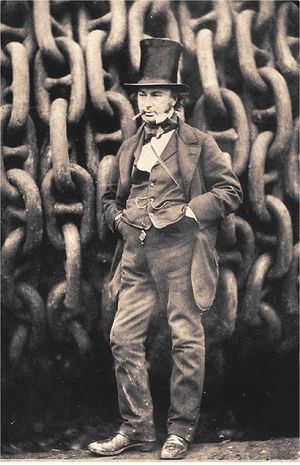 | |
| وُلِدَ | 9 أبريل 1806 پورتسموث، إنگلترة |
| توفي | 15 سبتمبر 1859 (aged 53) لندن، إنگلترة |
| القومية | بريطاني |
| التعليم | ليسيه هنري الرابع جامعة كاين |
| المهنة | مهندس |
| الزوج | ماري إليزابث هورسلي |
| الأنجال | إيزمبارد برونل الأصغر، هنري مارك برونل، فلورنس ماري برونل |
| الوالدان | مارك إيزمبارد برونل صوفيا كنگدم |
| السيرة الهندسية | |
| المجال | مهندس مدني مهندس إنشائي |
| الهيئات | معهد المهندسين المدنيين |
| المشاريع | سكة حديد گريت وسترن جسر كليفتون المعلق گريت بريتن |
| التوقيع | |
 | |
إيزمبارد كنگدم برونل Isambard Kingdom Brunel، FRS (/ˈɪzəmb[invalid input: 'ar']d br[invalid input: 'oo']ˈnɛl/؛ 9 أبريل 1806 – 15 سبتمبر 1859)، كان مهندساً مدنياً وميكانيكياً إنگليزياً، بنى أرصفة موانئ، سكة حديد گريت وسترن، وسلسلة من البواخر ضمت أول عابرة للأطلسي بمروحة دافعة والعديد من الجسور الهامة. كانت تصميماته بمثابة ثورة في النقل العام والهندسة الحديثة.
مع أن مشروعات برونل لم تكن دائماً ناجحة، إلى أنها عادة ما كانت تحتوي على حلول إبداعية للمشكلات الهندسية طويلة الأمد. خلال حياته العملية القصيرة، أنجز برونل الكثير من "الأعمال الهندسية الأولى من نوعها"، منها المساعدة في بناء أول نفق تحت نحر ملاحي وتطوير إسإس گريت بريتن، أول سفينة حديدة بمروحة دافعة ترتاد المحيطات، والتي كانت في وقتها (1843) أيضاً أكبر سفينة بُنيت على الإطلاق.[1][2]
وضع برونل المعيار لسكك حديدية جيدة البناء، مستخدماً مسوحات دقيقة لتقليل الدرجات والمنحنيات. استلزم هذا تقنيات إنشاء باهظة وجسور ومجاري مائية علوية جديدة، ونفق مربع بطول ميلين. من أكثر الخصائص المثيرة للجدل المقياس، "المقياس العريض" الذي يبلغ 4 ft 8 1⁄2 in (1٬435 mm). المقياس العريض كان إضافة لراحة الراكب لكنه زاد من تكلفة الإنشاءات وتسبب في صعوبات عندما استلزم في نهاية المطاف ربطه بالسكك الحديدية الأخرى ذات المقياس الأضيق. نتيجة قانون تنظيم قياس السكك الحديدية 1846، تغير المقياس إلى مقياس قياسي من خلال شبكة GWR.
أدهش برونل بريطانيا باقتراح مد سكك حديد گريت وسترن غرباً إلى أمريكا الشمالية عن طريق بناء سفن ذات بدن حديدي تعمل بالبخار. قام بتصميم وبناء ثلاث سفن أحدثت ثورة في الهندسة البحرية.
عام 2002، كان برونل الثاني في استطلاع الرأي العام الذي أجرته هيئة الإذاعة البريطانية لتحديد "البريطانيون المائة العظام". في 2006، في الذكرى المئوية الثانية لميلاده، كان هناك برنامج حافل بالأحداث، احتفالاً بحياته وعمله تحت اسمه برونل 200.[3]
الاسم
اسم برونل الفريد هو دمج لاسم والديه. ورث برونل اسم عائلة والده، والاسم الأوسط لعائلة والدته. كانت تركيبة الاسم هذه شائعة في ذلك الوقت. الاسم الأول لبرونل جاء من الاسم الاوسط لوالده، والذي كان اسمه المفضل أيضاً. "إيزمبارد" هو اسم نرويجي من أصل ألماني، ويعني "البريق الحديدي".[4] الاسم المشابه هو اللقب الألماني "إيزنبرات"، والذي لا يزال موجوداً حتى اليوم بين الباڤاريين والأمريكان-الألمان.
النشأة
كابن للمهندس المدني الفرنسي مارك إيزمبارد برونل وصوفيا كنگدم، وُلد إزيمبارد كنگدم برونل في 9 أبريل 1806 في شارع بريتن، پورتسي، پورتسموث، هامپشاير،[5] حيث كان والده يعمل على آلة لصنع الحواجز.[6][7] كان لديه أختين أكبر منه، صوفيا (الطفلة الأكبر، صوفيا[8]) وإما وانتقلت العائلة كلها إلى لندن عام 1808 لظروف عملوالده. عاش برنول طفولة سعيدة، بالرغم من المخاوف المالية الدائمة لعائلته، حيث كان والده مدرساً له في سنواته المبكرة. كان والده يعلمه الرسم والتقنيات الرصدية من سن الرابعة وعند بلوغه الثامنة كان برونل قد تعلم الهندسة الإقليدية. في ذلك الوقت كان قد تعلم أيضاً الفرنسية بطلاقة والمبادئ الأساسية للهندسة. كان يمتلك الشجاعة لرسم المباني المثيرة للإهتمام والتعرف على أية أخطاء في هياكلها.[9][10]
عندما كان برونل في الثامنة من عمره تم إرساله إلى مدرسة د. مورل الداخلية في هوڤ، حيث تعلم العلوم الكلاسيكية. والده، الفرنسي المولد، قرر أنه لابد لبرونل أن يتلقى تعليم عالي الجودة كالذي تلقاه هو في شبابه في فرنسا؛ تبعاً لذلك، في سنة الرابعة عشر، التحق الشاب برونل لأول مرة بجامعة كاين في نورماندي، ثم ليسيه هنري الرابع في پاريس.[9][11]
عندما كان برونل في الخامسة عشر، والده، الذي كانت ديونه المتراكمة قد وصلت إلى 5.000 جنيه إسترليني، دخل سجن المدين. بعد ثلاثة أشهر وعدم ظهور أي أمل لإطلاق سراحه، أعلن مارك أنه يدرس عرضاً من قيصر روسيا. في أغسطس 1821، مواجهة احتمالية خسارة مهندس بارز، رضخت الحكومة وأعطت لمارك 5.000 جنيه إسترليني لتسوية ديونه مقابل وعد منه بالبقاء في بريطانيا.[12][13]
عندما أنهى برنول دراسته في ليسيه هنري الرابع عام 1822، كان والده قد رشحه للإلتحاق بمدرسة الهندسة الشهيرة المدرسة متعددة التكنولوجيات بپاريس، لكن كأجنبي أُعتبر أنه غير مؤهل للدخول. لاحقاً درس برونل تحت إشراف صانع الساعات والبنكاماتي البارز أبراهام-لويس بريگو، الذي أشاد بإمكانيات برونل في رسائل إلى والده.[9] في أواخر 1822، عاد برونل إلى إنگلترة، بعد أن أنهى تدريبه.[11]
نفق التايمز
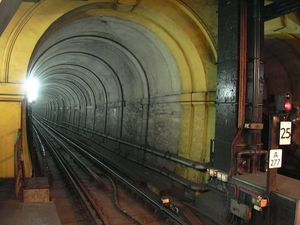
عمل برونل لعدة سنوات كمساعد مهندس في مشروع لإنشاء نفق تحت نهر التايمز بلندن يربط بين روثرهيث وواپينگ، حيث كان عمال الأنفاق ينقلون الإسطوانات العمودية من ضفة النهر إلى الضفة الأخرى في ظروف بالغة الصعوبة والخطورة. والد برونل، مارك، كان كبير المهندسين، وكان المشروع ممول من شركة نفق التايمز.[14]
كان تكوين النهر في روثرهيث في كثير من الأحيان من الرواسب الأكثر تشبعاً بالماء ويفقد الحصى. درع حفر الأنفاق المبتكر الذي صممه مارك برونل ساعد على حماية العمل من انهيار الكهوف،[15] لكن وقعت حادثتي فيضانات شديدة أوقفت العمل لفترات طويلة، وتسببت في مقتل الكثير من العمل وإصابة برونل الشاب بجروح خطيرة.[16] الحادث الأخير، عام 1828، تسبب في مقتل إثنين من كبار عمال المناجم، ونجا برونل نفسه من الموت بأعجوبة. كانت إصابته خطيرة، واستغرق ستة أشهر ليتعافى.[17] هذا الحدث أوقف العمل في النفق لعدة أعوام.[18]
مع أن نفق التايمز اكتمل في النهاية في حياة مارك برونل، his son had no further involvement with the tunnel proper, مستخدماً فقط الأعمال المهجورة في روثرهيث لأداء المزيد من تجاربه الفاشلة على الغاز. كان هذا اعتماداً على فكرة والده، لكن بالرغم من اهتمام عدة أطراف (من بينها الأميرالية) إلا أن التجارب قد توقفت عام 1834.
عام 1865 اشترت شركة سكك حديد شرق لندن نفق التايمز مقابل 200.000 جنيه إسترليني وبعد أربعة سنوات مرت فيه أولى القطارات. لاحقاً أصبح النفق جزءاً من نظام أنفاق لندن، وظل قيد الاستخدام حتى اليوم، في الأصل كجزء من خط شرق لندن الذي أُدمج الآن في London Overground.[19]
الجسور
قد تكون أفضل ذكرى لبرونل هو تصميمه جسر كليتون المعلق في بريستول. يمتد الجسر لمسافة 214 متر، و76 متر اسمياً فوق نهر آڤون، وكان لديه أطول امتداد لأي جسر في العالم وقت إنشاءه. قدم برونل أربع تصميمات للجنة التي كان يترأسها توماس تلفورد، لكنه تلفورد رفضها كلها، واقترح تصميمه الخاص بدلاً منها. المعارضة الشرسة من الرأي العام أجبرت اللجنة المنظمة لعقد مسابقة جديدة، والتي فاز بها برونل.[20]
بعدئذ، كتب برونل إلى صهره، السياسي رنجامين هاوس: "بعد كل المأثر التي أنجزتها، منذ أن كنت في هذه المنطقة في العالم، فكرت أمس في أن أقوم بأكثر الإنجازات روعة. I produced unanimity among 15 men who were all quarrelling about that most ticklish subject— taste".[21]
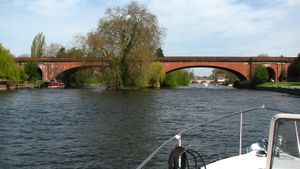
بدأ العمل على جسر كليفتون عام 1831، لكنه عُلق بسبب أحداث شغب ميدن الملكة التي سببها وصول سير تشارلز وذرل إلى كليفتون. طرد المشاغبون المستثمرين، تاركين المشروع بدون أموال، وتوقفت أعمال الإنشاء.[22][23]
لم يعش برونل ليرى اكتمال بناء الجسر، بالرغم من أن زملائه ومعجبيه في معهد المهندسين المدنيين شعروا أن هذا سيكون نصباً تذكارياً مناسباً، وبدأوا في جلب تمويلا جديدة وفي تعديل التصميم. أستؤنف العمل عام 1892 واكتمل عام 1864، بعد خمس سنوات من وفاة برونل.[21] أُقترح عام 2011، من قبل المؤرخ وكاتب السيرة أدريان ڤوگهان، أن برونل لم يصمم الجسر، كما تم بناؤه في نهاية المطاف، حيث أنه تم التغييرات الأخيرة التي أدخلت على التصميم كانت كبيرة.[24] عكست آراؤه وجهة النظر التي أعلنها توم رولت قبل إثنين وخمسين عاماً في كتابه الذي نشره عام 1959 بعنوان برونل.إعادة هندسة سلاسل التعليق التي تم جلبها من جسر معلق سابق كان واحداً من الأسباب الكثيرة لعدم اتباع تصميم برنل تماماً.
في مايو 1845 تم افتتاح جسر هنگفورد، جسر مشاة معلق يعبر التايمز بالقرب من محطة عبور تشارينگ في لندن. كان امتداده 767.5 قدم، ووصلت تكلفته إلى 106.000 جنيه إسترليني.[25] عام 1859 أُستبدل بجسر سكك حديد جديد، وتم استخدام سلاسل التعليق لإكمال جسر كليتون المعلق.[20]
لا يزال جسر كليفتون المعلق قائماً، وتمر عليه سنوياً أكثر من 4 مليون مركبة.[26]
قام برونل بتصميم الكثير من الجسور من أجل مشروعاته للسكك الحديدية، منها جسر ألبرت الملكي الذي يمتد فوق نهر تمار عند سالتاش بالقرب من پليموث، جسر سمرست (جسر مؤطر بالأخشاب بطريقة فريدة بالقرب من بريدجواتر[27])، جسر سكك حديد ويندسور، وجسر سكك حديد ميدنهيد على التايمز في بركشاير. كان الأخير هو أكثر جسور قناطر الطوب تسطحاً واتساعاً في العالم ولا يزال يحمل خط القطارات الرئيسي إلى الغرب، رغم أن قطارات اليوم تبلغ سرعتها عشرة أضعاف القطارات في وقت برونل.[28]
طوال عمله في بناء السكك الحديدية، لكن بصفة خاصة أثناء عمله على سكك حديدي كورنوال وساوث ديڤون حيث كان الاقتصاد مطلوباً وكان هناك الكثير من الوديان التي يجب اجتيازها، استخدم برونل الأخشاب بكثرة لبناء الجسور المائية العلوية الكبيرة؛[29] التي حلت محل خاماتهم الأساسية التي استخدموها على مدار سنوات، خشب الأرز البلطيقي الكياني أصبح الحصول عليه غير اقتصادي.
قام برونل بتصميم جسر ألبرت الملكي عام 1855 لسكك حديد كورنول، بعد رفض البرلمان خطته الأصلية لعبارة قطارات تعبر الهامواز- لمصب المد الجزر عند تامار، تاڤي، ولينهر. يتكون الجسر (of bowstring girder أو tied arch construction) من 455 ft (139 m)، 100 ft (30 m) فوق متوسط المد الربيعي، بالإضافة إلى 17 امتداد أقصر بكثير. افتتحه الأمير ألبرت في 2 مايو 1859، واكتملت في السنة التي توفي فيها برونل.[30]
الكثير من جسورد برونل على سكك حديد گريت وسترن تم هدمها بسبب الخط الذي تم كهربته، ولم تكن هناك مساحة كافية لأسلاك إضافية. مجلس مقاطعة بكنگهامشاير يجري مناقشة حول خيارات أخرى يمكن اتخاذها، بهدف أن يتم إنقاذ الجسور التاريخية التسعة كلها الموجودة على الخط.[31][32]
سكة حديد "گريت وسترن"
| Track gauge | ||||||||||||||||||||||||||||||||||||||||||||||||||||||||||||||||||||||||||||||
|---|---|---|---|---|---|---|---|---|---|---|---|---|---|---|---|---|---|---|---|---|---|---|---|---|---|---|---|---|---|---|---|---|---|---|---|---|---|---|---|---|---|---|---|---|---|---|---|---|---|---|---|---|---|---|---|---|---|---|---|---|---|---|---|---|---|---|---|---|---|---|---|---|---|---|---|---|---|---|
| Break-of-gauge - Dual gauge | ||||||||||||||||||||||||||||||||||||||||||||||||||||||||||||||||||||||||||||||
| Gauge conversion (list) - Bogie exchange - Variable gauge | ||||||||||||||||||||||||||||||||||||||||||||||||||||||||||||||||||||||||||||||
| Rail track - Tramway track | ||||||||||||||||||||||||||||||||||||||||||||||||||||||||||||||||||||||||||||||
| ||||||||||||||||||||||||||||||||||||||||||||||||||||||||||||||||||||||||||||||
في المرحلة المبكرة من حياة برونل، بدأ استخدام السكك الحديدية كوسيلة رئيسية لنقل البضائع. أثر هذا على دخول برونل لمجال هندسة السكك الحديدية، والتي تشمل هندسة جسور السكك الحديدية.
عام 1833، قبل اكتمال نفق التايمز، كان برونل قد عُين كبير مهندسي سكة حديد گريت وسترن، إحدى العجائب الڤكتورية البريطانية، والتي تمتد من بريستول إلى إكستر.[33] تأسست الشركة في اجتماع عام في بريستول عام 1883، ودُمجت بموجب قانون البرلمان عام 1835. كانت رؤية برونل أنه سيكون بمقدور الركاب شراء تذكرة واحدة في لندن پدينگتون والسفر من لندن إلى نيويورك، بالتغيير من سكة حديد گريت وسترن إلى السفينة البخارية گريت وسترن في المحطة الأخيرة في نايلاند، جنوب ويلز.[33] قام بنفسه بمسح طول المسار بالكامل بين لندن وبريستول، بمساعدة الكثير من بينهم محاميه جرميا اوسبورن من مكتب بريستول القانوني، اوبسبورن كلارك الذي في إحدى المناسبات جدف بنفسه مع إيزمبارد كنگدم برونل في نهر آيڤون لمسح ضفة النهر من أجل المسار.[34][35]
اتخذ برونل قرارين جدليين: الأول هو استخدام سكة عريضة تبلغ 7 أقدام للقضيب، والتي كان يعتقد أنها ستوفر ميزة للجري على سرعات عالية؛ والثاني هو عدم اتخاذ المسار الذي يعبر شمال مارلبورو داونز-منطة لا تضم بلدات هامة، على الرغم من اقتراحه وصلات محتملة إلى اوكسفورد وگلوستر- ثم المتابعة عبر وادي التايمز وصولاً إلى لندن. قراره باستخدام سكة عريضة للخط كان محل جدل لأن معظم السكك الحديدية تقريباً تستخدم حتى الآن السكك المعيارية. قال برونل أن هذا لم يكن سوى ترحيل من سكك حديد المناجم التي عمل عليها جورج ستفنسون في السابق لعمل أول سكك حديد ركاب في العالم. أثبت برونل عن طريق الحساب وسلسلة من التجارب أن سكته الأعرض كانت الحجم الأمثل لتوفير السرعات العالية[36] والركوب المستقر والمريح للركاب. بالإضافة إلى ذلك، فإن السكة الأوسع أتاحت استخدام عربات أكبر وبالتالي قدرة شحن أكبر.[37]
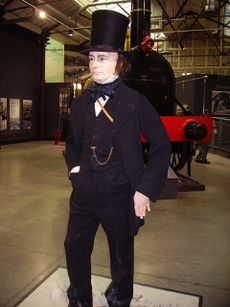
بالاعتماد على خبرة برونل في نفق التايمز، إحتوت گريت وسترن على سلسلة من الإنجازات-المجاري المائية العلوية مثل تلك الموجودة في إيڤبردج، خاصة المحطات المصممة، والأنفاق الواسعة ومنها النفق المربع، والذي كان يعتبر أطول نفق سكك حديدية في العالم في ذلك الوقت.[38] هناك رواية تقول أن النفق المربع ربما قد توجيهه لهذا الاتجاه حتى تدخله أشعة الشمس من جميع الجهات في يوم ميلاد برونل.[39]
مجموعة القاطرات الأولى التي أمر برونل بنصنعها بمواصفاته الخاصة، تبين أنها غير مرضية، بغض النظر عن قاطرة نورث ستار، دانيال گوتش الذي كان يبلغ 20 عاماً (لاحقاً سير دانيال) تم تعيينه مراقب محركات القاطرات. اختار برونل وگوتش وضع أشغال القاطرات في قرية سويندون، عند النقطة التي تصعد تدريجياً من لندن للتحول إلى النزول الحاد إلى وادي آيڤون عند باث.
إنجازات برونل أشعلت المخيلة التقنية للبريطانيين في ذلك الوقت، وسرعان ما أصبح برونل شهيراً في تلك البلاد على خلفية هذا الاهتمام.[40]
بعد وفاة برونل تم اتخاذ قرار بوجوب استخدام السكة القياسية في جميع السكك الحديدية بالبلاد. بالرغم من إثبات گريت وسترن أن استخدام السكة الأعرض كان أفضل (محل نزاع من أحد مؤرخي برونل على الأقل[من؟])، اتخذ القرار باستخدام سكة ستفنسون القياسية. ومع ذلك، بحلول مايو 1892 عندما أُلغيت السكة العريضة كانت گريت وسترن قد استبدلت سككها بالفعل بالسكة المزدوجة (العريضة والقياسية) وهكذا كان النقل غير مؤلم نسبياً.[بحاجة لمصدر] في آخر محطات ويلز من گريت وسترن عند نايلاند، كانت قطاعات السكك الحديدية ذات القياس العريض تستخدم كدرابزين في كوايسايد، وعدد من لوحات المعلومات التي تصور جوانب مختلفة من حياة برونل. هناك أيضاً تمثال برونزي برونزي بحكم أكبر من الطبيعي لبرونل حاملاً سفينة بخارية في يد وفي اليد الأخرى قاطرة.[41][42]
محطة لندن پادينگتون الحالية صممها برونل وأُفتتحت عام 1854. هناك أمثلة من تصميماته لمحطات أصغر على سكة حديد گريت وسترن وخطوط مرتبطة بها لا تزال في حالة جيدة ومن بينها محطة سكة حديد مورتايمر، تشارلبري وبريدجند (جميعها على الطراز المعماري الإيطالي والكولهامي والتيودوري). من الأمثلة الباقية على train sheds الخشبية على الطراز المنتشر في عصره تلك الموجودة في فروم[43] وكينگسوير.[44]
كان أعظم إنجاز هو سكة حديد گريت وسترن والتي تم تخليدها في متحف سويندون للسكك الحديدية البخارية[45] ومركز سكك حديد ديدكوت. يشتهر مركز سكك حديد ديدكوت لإحتوائه على قطاعات مسارات أعيد بناؤها بطول 7 ft 1⁄4 in (2٬140 mm) Brunel gauge، بالإضافة إلى تشغيل نادر للغاية لقطارة بخارية بنفس القياس.
علاوة على ذلك، كانت هناك آراء سلبية مثل كيف كان ينظر المجتمع للسكك الحديدية. شعر بعض ملاك الأراضي أن السكك الحديدة تمثل تهديداً لراحتهم أو قيمة ممتلكاتهم وطلب آخرون حفر أنفاق في أراضيهم حتى تحجب رؤية السكك الحديدية.[36]
Brunel's "atmospheric caper"
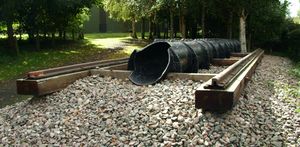
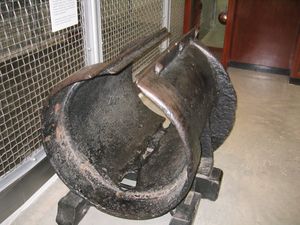
Though unsuccessful, another of Brunel's interesting use of technical innovations was the atmospheric railway, the extension of the Great Western Railway (GWR) southward from Exeter towards Plymouth, technically the South Devon Railway (SDR), though supported by the GWR. Instead of using locomotives, the trains were moved by Clegg and Samuda's patented system of atmospheric (vacuum) traction, whereby stationary pumps sucked air from a pipe placed in the centre of the track.[46]
The section from Exeter to Newton (now Newton Abbot) was completed on this principle, and trains ran at approximately 68 أميال في الساعة (109 km/h).[47] Pumping stations with distinctive square chimneys were sited at two-mile intervals.[47] Fifteen-inch (381 mm) pipes were used on the level portions, and 22-بوصة (559 mm) pipes were intended for the steeper gradients.
The technology required the use of leather flaps to seal the vacuum pipes. The natural oils were drawn out of the leather by the vacuum, making the leather vulnerable to water, rotting it and breaking the fibres when it froze during the winter of 1847. It had to be kept supple with tallow, which is attractive to rats. The flaps were eaten, and vacuum operation lasted less than a year, from 1847 (experimental service began in September; operations from February 1848) to 10 September 1848.[48] Deterioration of the valve due to the reaction of Tannin and Iron Oxide has been cited as the last straw that sank the project, as the continuous valve began to tear from its rivets over most of its length, and the estimated replacement cost of £25,000 was considered prohibitive.
It has been suggested that the whole project was an expensive flop. In Brunel's favour, it has been noted that he had the courage to call a halt to the venture instead of struggling on with it at greater cost.
The system never managed to prove itself. The accounts of the SDR for 1848 suggest that atmospheric traction cost 3s 1d (three shillings and one penny) per mile compared to 1s 4d/mile for conventional steam power (because of the many operating issues associated with the atmospheric, few of which were solved during its working life, the actual cost efficiency proved impossible to calculate). A number of South Devon Railway engine houses still stand, including that at Totnes (scheduled as a grade II listed monument in 2007 to prevent its imminent demolition, even as Brunel's bicentenary celebrations were continuing) and at Starcross, on the estuary of the River Exe, which is a striking landmark, and a reminder of the atmospheric railway, also commemorated as the name of the village pub.[49][50]
A section of the pipe, without the leather covers, is preserved at the Didcot Railway Centre.[51]
السفن العابرة للأطلسي
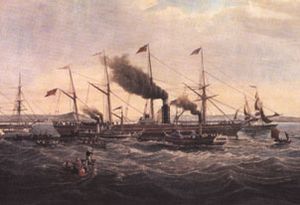
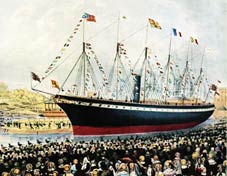
In 1835, before the Great Western Railway had opened, Brunel proposed extending its transport network by boat from Bristol across the Atlantic Ocean to New York City. The Great Western Steamship Company was formed by Thomas Guppy for that purpose. It was widely disputed whether it would be commercially viable for a ship powered purely by steam to make such long journeys. Technological developments in the early 1830s—including the invention of the surface condenser, which allowed boilers to run on salt water without stopping to be cleaned—made longer journeys more possible, but it was generally thought that a ship would not be able to carry enough fuel for the trip and have room for a commercial cargo. Brunel formulated the theory that the amount a ship could carry increased as the cube of its dimensions, whereas the amount of resistance a ship experienced from the water as it travelled only increased by a square of its dimensions. This would mean that moving a larger ship would take proportionately less fuel than a smaller ship. To test this theory, Brunel offered his services for free to the Great Western Steamship Company, which appointed him to its building committee and entrusted him with designing its first ship, the Great Western.[52] [53][54]
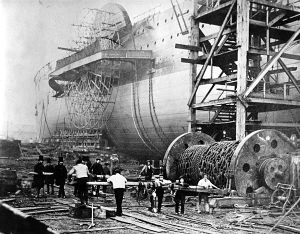
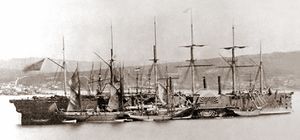
When it was built, the Great Western was the longest ship in the world at 236 ft (72 m) with a 250-قدم (76 m) keel. The ship was constructed mainly from wood, but Brunel added bolts and iron diagonal reinforcements to maintain the keel's strength. In addition to its steam-powered paddle wheels, the ship carried four masts for sails. The Great Western embarked on her maiden voyage from Avonmouth, Bristol, to New York on 8 April 1838 with 600 long ton (610،000 kg) of coal, cargo and seven passengers on board. Brunel himself missed this initial crossing, having been injured during a fire aboard the ship as she was returning from fitting out in London. As the fire delayed the launch several days, the Great Western missed its opportunity to claim title as the first ship to cross the Atlantic under steam power alone. Even with a four-day head start, the competing Sirius arrived only one day earlier and its crew was forced to burn cabin furniture, spare yards and one mast for fuel. In contrast, the Great Western crossing of the Atlantic took 15 days and five hours, and the ship arrived at her destination with a third of its coal still remaining, demonstrating that Brunel's calculations were correct. The Great Western had proved the viability of commercial transatlantic steamship service, which led the Great Western Steamboat Company to use her in regular service between Bristol and New York from 1838 to 1846. She made 64 crossings, and was the first ship to hold the Blue Riband with a crossing time of 13 days westbound and 12 days 6 hours eastbound. The service was commercially successful enough for a sister ship to be required, which Brunel was asked to design.[53][55][56]
Brunel had become convinced of the superiority of propeller-driven ships over paddle wheels. After tests conducted aboard the propeller-driven steam tug Archimedes, he incorporated a large six-bladed propeller into his design for the 322-قدم (98 m) Great Britain, which was launched in 1843.[57] Great Britain is considered the first modern ship, being built of metal rather than wood, powered by an engine rather than wind or oars, and driven by propeller rather than paddle wheel. She was the first iron-hulled, propeller-driven ship to cross the Atlantic Ocean.[58] Her maiden voyage was made in August and September 1845, from Liverpool to New York. In 1846, she was run aground at Dundrum, County Down. She was salvaged and employed in the Australian service.[59] And today she is fully preserved and open to the public in Bristol, UK.
In 1852 Brunel turned to a third ship, larger than her predecessors, intended for voyages to India and Australia. The Great Eastern (originally dubbed Leviathan) was cutting-edge technology for her time: almost 700 ft (210 m) long, fitted out with the most luxurious appointments, and capable of carrying over 4,000 passengers. Great Eastern was designed to cruise non-stop from London to Sydney and back (since engineers of the time misunderstood that Australia had no coal reserves), and she remained the largest ship built until the start of the 20th century. Like many of Brunel's ambitious projects, the ship soon ran over budget and behind schedule in the face of a series of technical problems.[60] The ship has been portrayed as a white elephant, but it has been argued by David P. Billington that in this case Brunel's failure was principally one of economics—his ships were simply years ahead of their time.[61] His vision and engineering innovations made the building of large-scale, propeller-driven, all-metal steamships a practical reality, but the prevailing economic and industrial conditions meant that it would be several decades before transoceanic steamship travel emerged as a viable industry.[61]
Great Eastern was built at John Scott Russell's Napier Yard in London, and after two trial trips in 1859, set forth on her maiden voyage from Southampton to New York on 17 June 1860.[62] Though a failure at her original purpose of passenger travel, she eventually found a role as an oceanic telegraph cable-layer. Under Captain Sir James Anderson, the Great Eastern played a significant role in laying the first lasting transatlantic telegraph cable, which enabled telecommunication between Europe and North America.[63][64]
مستشفى رنكيوي
أثناء 1854، دخلت بريطانيا حرب القرم، and an old Turkish barracks became the British Army Hospital in Scutari. Injured men contracted a variety of illnesses—including cholera, dysentery, typhoid and malaria—due to poor conditions there,[65] and Florence Nightingale sent a plea to The Times for the government to produce a solution.
Brunel was working on the Great Eastern amongst other projects, but accepted the task in February 1855 of designing and building the War Office requirement of a temporary, pre-fabricated hospital that could be shipped to Crimea and erected there. In 5 months the team he had assembled designed, built, and shipped pre-fabricated wood and canvas buildings, providing them complete with advice on transportation and positioning of the facilities.[66]
Brunel had been working Gloucester Docks-based William Eassrie on the launching stage for the Great Eastern, a man who had designed and built wooden prefabricated huts used in both the Australian gold rush, as well as by the British and French Armies in the Crimea. Using wood supplied by timber importers Price & Co., Eassrie fabricated 18 of the two-50 patient wards designed by Brunel, shipped directly via 16 ships from Gloucester Docks to the Dardanelles. The Renkioi Hospital was subsequently erected near Scutari Hospital, where Nightingale was based, in the malaria-free area of Renkioi.[67]
His designs incorporated the necessities of hygiene: access to sanitation, ventilation, drainage, and even rudimentary temperature controls. They were feted as a great success, with some sources stating that of the approximately 1,300 patients treated in the hospital, there were only 50 deaths.[68] In the Scutari hospital it replaced, deaths were said to be as many as 10 times this number. Nightingale referred to them as "those magnificent huts".[69] The practice of building hospitals from pre-fabricated modules survives today,[67] with hospitals such as the Bristol Royal Infirmary being created in this manner.
حياته الخاصة
في 1830، أختير ليصبح زميل الجمعية الملكية.
On 5 July 1836, Brunel married Mary Elizabeth Horsley (و. 1813), who came from an accomplished musical and artistic family, being the eldest daughter of composer and organist William Horsley. They established a home at Duke Street, Westminster, in London.[70]
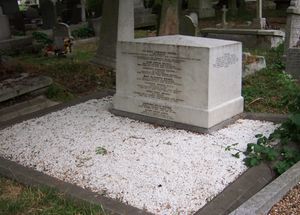
In 1843, while performing a conjuring trick for the amusement of his children, Brunel accidentally inhaled a half-sovereign coin, which became lodged in his windpipe. A special pair of forceps failed to remove it, as did a machine devised by Brunel to shake it loose. At the suggestion of his father, Brunel was strapped to a board and turned upside-down, and the coin was jerked free.[71] He recuperated at Teignmouth, and enjoyed the area so much that he purchased an estate at Watcombe in Torquay, Devon. Here he designed Brunel Manor and its gardens to be his retirement home. He never saw the house or gardens finished, as he died before it was completed.
Brunel, a heavy smoker,[72] suffered a stroke in 1859, just before the Great Eastern made her first voyage to New York.[73] He died ten days later at the age of 53 and was buried, like his father, in Kensal Green Cemetery in London.[74] The grave is insignificant by the standards of the cemetery and easily missed. It lies south of the main central path, midway between the entrance and the central chapel, around 20m from the path and screened by trees.
He left behind his wife Mary and three children: Isambard Brunel Junior (1837–1902), Henry Marc Brunel (1842–1903) and Florence Mary Brunel (1847–1876). Henry Marc followed his father and grandfather in becoming a successful civil engineer.[75][76]
ذكراه
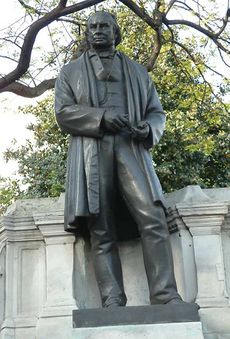
A celebrated engineer in his era, Brunel remains revered today, as evidenced by numerous monuments to him. There are statues in London at Temple (pictured), Brunel University and Paddington station, and in Bristol, Plymouth, Swindon, Milford Haven and Saltash. A statue in Neyland was stolen in August 2010.[77] The topmast of the Great Eastern is used as a flagpole at the entrance to Anfield, Liverpool Football Club's ground.[78] Contemporary locations bear Brunel's name, such as جامعة برونل في لندن،[79] مركز تسوق في بلتشلي، ملتون كينز، ومجموعة من الشوارع في إكستر: Isambard Terrace, Kingdom Mews, and Brunel Close. A road, car park, and school in his home city of Portsmouth are also named in his honour, along with one of the city's largest public houses.[80] There is an engineering lab building at the University of Plymouth named in his honour.
In a 2002 public television poll conducted by the BBC to select the 100 Greatest Britons, Brunel was placed second, behind Winston Churchill.[81] Brunel's life and works have been depicted in numerous books, films and television programs. The 2003 book and BBC TV series Seven Wonders of the Industrial World included a dramatisation of the building of the Great Eastern.
Many of Brunel's bridges are still in use. Brunel's first engineering project, the Thames Tunnel, is now part of the London Overground network. The Brunel Engine House at Rotherhithe, which once housed the steam engines that powered the tunnel pumps, now houses the Brunel Museum dedicated to the work and lives of Marc and Isambard Kingdom Brunel.[82] Many of Brunel's original papers and designs are now held in the Brunel Institute alongside the SS Great Britain in Bristol, and are freely available for researchers and visitors.
Brunel is credited with turning the town of Swindon into one of the fastest growing towns in Europe during the 19th century.[83] Brunel's choice to locate the Great Western Railway locomotive sheds there caused a need for housing for the workers, which in turn gave Brunel the impetus to build hospitals, churches and housing estates in what is known today as the 'Railway Village'.[84] According to some sources, Brunel's addition of a Mechanics Institute for recreation and hospitals and clinics for his workers gave Aneurin Bevan the basis for the creation of the National Health Service.[85]
GWR Castle Class steam locomotive no. 5069 was named Isambard Kingdom Brunel,[86] after the engineer;[87] and BR Western Region class 47 diesel locomotive no. D1662 (later 47484) was also named Isambard Kingdom Brunel.[88] GWR's successor First Great Western has named its high-speed train power car no. 43003 "Isambard Kingdom Brunel".
In 2006 the Royal Mint struck two £2 coins to "celebrate the 200th anniversary of Isambard Kingdom Brunel and his achievements".[89] The first depicts Brunel with a section of the Royal Albert Bridge and the second shows the roof of Paddington Station. The Post Office issued a set of commemorative stamps.
For the 100-year anniversary of the Royal Albert Bridge, the words "I.K. BRUNEL ENGINEER 1859" were engraved on either end to commemorate his enduring legacy. The words had become obscured by paint, but were restored by Network Rail and revealed again in 2006.[90]
Brunel was the subject of Great, a 1975 animated film directed by Bob Godfrey. It won the Academy Award for Animated Short Film at the 48th Academy Awards in March 1976.[91]
At the 2012 Summer Olympics opening ceremony, Brunel was portrayed by Kenneth Branagh in a segment showing the Industrial Revolution.[92]
The 2013 album The Last Ship by Sting includes the song "Ballad of the Great Eastern".[93]
انظر أيضاً
- Works of Isambard Kingdom Brunel
- Lindsey House – Isambard's childhood home
الهامش
- ^ Wilson (1994), pp. 202–3.
- ^ "Isambard Kingdom Brunel". SS Great Britain. 29 March 2006.
- ^ "Home". Brunel 200. Retrieved 22 July 2009.
- ^ Henry Harrison. Surnames of the United Kingdom: A Concise Etymological Dictionary. p. 230
- ^ Brindle, Steven (2005). Brunel: The Man Who Built the World. Weidenfield & Nicholson. p. 28. ISBN 0-297-84408-3.
{{cite book}}: Invalid|ref=harv(help) - ^ Brunel, Isambard (1870), p. 2.
- ^ Timbs, John (1860). Stories of inventors and discoverers in science and the useful arts, pp. 102, 285–6. London: Kent and Co. OCLC 1349834.
- ^ http://tracingancestors-uk.com/genealogies-of-the-famous/isambard-kingdom-brunel-family-history
- ^ أ ب ت Buchanan (2006), p. 18
- ^ Gillings (2006), pp. 1, 11
- ^ أ ب Brunel, Isambard (1870), p. 5.
- ^ Gillings (2006), pp. 11–2.
- ^ Worth, Martin (1999). Sweat and Inspiration: Pioneers of the Industrial Age, p. 87. Alan Sutton Publishing Ltd. ISBN 978-0-7509-1660-8.
- ^ Dumpleton and Miller (2002), pp. 14–15
- ^ Aaseng, Nathan (1999). Construction: Building The Impossible (Innovators Series). The Oliver Press, Inc. pp. 36–45. ISBN 1-881508-59-5.
- ^ Smith, Denis (2001). Civil Engineering Heritage: London and the Thames Valley. Thomas Telford Ltd, for The Institution of Civil Engineers. pp. 17–19. ISBN 978-0-7277-2876-0. Retrieved 16 August 2009.
- ^ Sources disagree about where Brunel convalesced; Buchanan (p. 30) says Brighton, while Dumpleton and Miller (p. 16) say Bristol and connect this to his subsequent work on the Clifton Suspension Bridge there.
- ^ Dumpleton and Miller (2002), p. 15
- ^ Bagust, Harold, "The Greater Genius?", 2006, Ian Allan Publishing, ISBN 0-7110-3175-4, (pages 97–100)
- ^ أ ب "The Clifton Suspension Bridge". Brunel 200. Retrieved 16 August 2009.
- ^ أ ب Peters, Professor G Ross. "Brunel: 'The Practical Prophet'". BBC History. Retrieved 27 August 2009.
- ^ Bryan, Tim (1999). Brunel: The Great Engineer. Shepperton: Ian Allan. pp. 35–41. ISBN 978-0-7110-2686-5.
- ^ MacLeod, Donald (18 April 2006). "Higher diary". The Guardian. Retrieved 27 August 2009.
- ^ "Isambard Kingdom Brunel did not design Clifton Suspension Bridge, says historian". Telegraph.co.uk. Retrieved 22 December 2012.
- ^ "The Hungerford Suspension Bridge", The Practical Mechanic and Engineer's Magazine, May 1845, p223
- ^ "Get set to pay more on suspension bridge". Bristol Evening Post. 6 January 2007. p. 12.
- ^ Dunning, R W (1992). "Bridgwater". A History of the County of Somerset: Volume 6. British History Online. Retrieved 16 August 2009.
{{cite web}}: Unknown parameter|editors=ignored (|editor=suggested) (help) - ^ Gordon, J E (1978). Structures: or why things don't fall down. London: Penguin. p. 200. ISBN 0-14-013628-2.
- ^ Lewis, Brian (18 June 2007). Brunel's timber bridges and viaducts. Hersham: Ian Allan Publishing. ISBN 978-0-7110-3218-7.
- ^ "History". Royal Albert Bridge. Retrieved 16 August 2009.
- ^ Senior Archaeological Officer (20 September 2006). "Crossrail and the Great Western World Heritage site" (PDF). Buckinghamshire Historic Environment Forum. Buckinghamshire County Council. Retrieved 16 August 2009.
- ^ "World Heritage Sites: The Tentative List of The United Kingdom of Great Britain and Northern Ireland" (PDF). Buildings, Monuments and Sites Division. Department for Culture, Media and Sport. 1999. Retrieved 16 August 2009.
- ^ أ ب Crittal, Elizabeth (1959). "Railways". A History of the County of Wiltshire: Volume 4. British History Online. Retrieved 16 August 2009.
- ^ "Clifton Rugby Football Club History".
- ^ "Brunel 200 – Working With Visionaries" (PDF).
- ^ أ ب Pudney, John (1974). Brunel and His World. Thames and Hudson. ISBN 978-0-500-13047-6.
- ^ Ollivier, John (1846). The Broad Gauge: The Bane of the Great Western Railway Company.
- ^ Dumpleton and Miller (2002), p. 20
- ^ Williams, Archibald (1904). The Romance of Modern Locomotion. C. A. Pearson Ltd.
- ^ "Isambard Kingdom Brunel: Obituary" (fee required). The Times. 19 September 1859. Retrieved 28 August 2009.
- ^ "Neyland – Brunel's railway town". Western Telegraph. 22 April 2006. Retrieved 16 August 2009.
- ^ "I.K.Brunel". www.brunel2006.info. Retrieved 16 August 2009.
- ^ "Frome Station roof". Engineering Timelines. Retrieved 27 August 2009.
- ^ "Kingswear Station". South Hams District Council. Archived from the original (PDF) on 28 August 2009. Retrieved 27 August 2009.
- ^ "Steam: Museum of the Great Western Railway". Swindon Borough Council. Retrieved 28 August 2009.
- ^ Buchanan, R A (May 1992). "The Atmospheric Railway of I.K. Brunel". Social Studies of Science (PDF; fee required). Sage Publications, Ltd. 22 (2): 231–243. doi:10.1177/030631292022002003. JSTOR 285614.
{{cite journal}}:|format=requires|url=(help) - ^ أ ب Dumpleton and Miller (2002), p. 22
- ^ Parkin, Jim (2000). Engineering Judgement and Risk. Institution of Civil Engineers. ISBN 978-0-7277-2873-9.
- ^ "Devon Railways". Teignmouth & Shaldon Museum. Retrieved 16 August 2009.
- ^ "Brunel and The Atmospheric Caper". Devon Heritage. Retrieved 16 August 2009.
- ^ "Broad Gauge Railway". Centre Guide. Didcot Railway Centre. Retrieved 16 August 2009.
- ^ Buchanan (2006), pp. 57–59
- ^ أ ب Beckett (2006), pp. 171–173
- ^ Dumpleton and Miller (2002), pp. 34–46
- ^ Buchanan (2006), pp. 58–59
- ^ Dumpleton and Miller (2002), pp. 26–32
- ^ Nasmyth, James (1897). Smiles, Samuel (ed.). James Nasmyth: Engineer, An Autobiography. Archived at Project Gutenberg. Retrieved 16 August 2009.
- ^ Lienhard, John H (2003). The Engines of Our Ingenuity. Oxford University Press (US). ISBN 978-0-19-516731-3.
- ^ Chisholm 1911.
- ^ Dumpleton and Miller (2002), pp. 94–113
- ^ أ ب Billington (1985), pp. 50–59
- ^ Mortimer, John (2005). Zerah Colburn: The Spirit of Darkness. Arima Publishing. ISBN 978-1-84549-196-3.
- ^ Dumpleton and Miller (2002), pp. 130–148
- ^ "The Atlantic Cable". The New York Times. 30 July 1866. Retrieved 28 August 2009.
- ^ "Report on Medical Care". British National Archives (WO 33/1 ff.119, 124, 146–7). Dated 23 February 1855.
- ^ "Prefabricated wooden hospitals". British National Archives (WO 43/991 ff.76–7). Dated 7 September 1855.
- ^ أ ب "Lessons from Renkioi" at the Internet Archive. Hospital Development Magazine. 10 November 2005. Retrieved 2009-09-22.
- ^ "Palmerston, Brunel and Florence Nightingale’s Field Hospital" (PDF). HMSwarrior.org. Retrieved 30 November 2006.
- ^ "Britain's Modern Brunels". BBC Radio 4. Retrieved 30 November 2006.
- ^ "The 1830s". Brunel 200. Retrieved 16 August 2009.
- ^ Dyer, T.F. Thiselton (2003). Strange Pages from Family Papers (1900). Kessinger Publishing. ISBN 978-0-7661-5346-2.
- ^ Ignacio Villarreal (6 January 2011). "Churchill, The Windsors and 420 Million Year Old Tree Trunk Star in Bonhams Gentleman's Library Sale". Artdaily.com. Retrieved 22 December 2012.
- ^ Cadbury, Deborah (2003). Seven Wonders of the Industrial World. Fourth Estate. ISBN 0-00-716304-5.
- ^ Skempton, A; Rennison, Robert William; CoxHumphreys, Rob (2002). Biographical Dictionary of Civil Engineers in Great Britain and Ireland v. 1 1500–1830. Thomas Telford Ltd. ISBN 0-7277-2939-X.
- ^ "Brunel Collection: Isambard Kingdom Brunel (1806–1859) papers". Archives Hub. Retrieved 16 August 2009.
- ^ Buchanan (2006), pp. 7–8
- ^ "BBC News: Brunel statue stolen from plinth". Bbc.co.uk. 23 August 2010. Retrieved 22 December 2012.
- ^ Pollard, Richard (2009). Lancashire: Liverpool and the southwest. Yale University Press. p. 397. ISBN 978-0-300-10910-8.
{{cite book}}: Unknown parameter|coauthors=ignored (|author=suggested) (help) - ^ "History". Brunel University. 2009. Retrieved 11 September 2009.
- ^ "The Isambard Kingdom Brunel, Portsmouth | Our Pubs". J D Wetherspoon. 12 April 2006. Retrieved 22 December 2012.
- ^ "Churchill voted greatest Briton". BBC News online. 24 November 2002. Retrieved 4 June 2009.
- ^ "Brunel Museum". Brunel Museum. Retrieved 16 August 2009.
- ^ Tye, Stephanie (20 January 2006). "How Town was put on the map by Brunel". Swindon Advertiser. Retrieved 22 September 2009.
- ^ Beckett (2006), pp. 115–122
- ^ "A Model for the NHS?". BBC Legacies. Retrieved 30 November 2006.
- ^ le Fleming 1960, p. H18
- ^ Davies 1993, p. P127
- ^ Marsden 1984, p. 66
- ^ "2006 Brunel The Man £2 Silver Proof". Royal Mint. Archived from the original on 22 May 2006. Retrieved 16 August 2009.
- ^ "Brunel Bicentennial Celebrations" (Press release). www.networkrailmediacentre.co.uk. 16 June 2009. Archived from the original on 28 September 2007. Retrieved 22 July 2009.
- ^ "The 48th Academy Awards (1976) Nominees and Winners". oscars.org. Retrieved 2 October 2011.
- ^ Boyle, Danny (28 July 2012). "Danny Boyle Welcomes The World To London". The Descrier. Retrieved 28 July 2012.
- ^ "Sting on tantric sex, Justin Bieber and pretentiousness". Guardian.com. Retrieved 28 September 2013.
المراجع
- Beckett, Derrick (2006). Brunel's Britain. David & Charles PLC. ISBN 978-0-7153-2360-1.
- Billington, David P. (1985). The Tower and the Bridge: The New Art of Structural Engineering. Princeton University Press. ISBN 978-0-691-02393-9.
- Brunel, Isambard (1870). The life of Isambard Kingdom Brunel, civil engineer. Longmans, Green & Co. OCLC 3202088.
- Buchanan, R. Angus (2006). Brunel: the life and times of Isambard Kingdom Brunel. Hambledon & London. ISBN 978-1-85285-525-3.
 Chisholm, Hugh, ed. (1911). . دائرة المعارف البريطانية (eleventh ed.). Cambridge University Press.
Chisholm, Hugh, ed. (1911). . دائرة المعارف البريطانية (eleventh ed.). Cambridge University Press. {{cite encyclopedia}}: Cite has empty unknown parameter:|coauthors=(help)- Davies, Ken (April 1993). The Locomotives of the Great Western Railway, part fourteen: Names and their Origins – ... Lincoln: RCTS. ISBN 0-901115-75-4.
{{cite book}}: Invalid|ref=harv(help) - Dumpleton, Bernard; Miller, Muriel (2002). Brunel's Three Ships. Intellect Books. ISBN 978-1-84150-800-9.
- Gillings, Annabel (2006). Brunel (Life & Times). Haus Publishers Ltd. ISBN 978-1-904950-44-8.
- le Fleming, H.M. (November 1960) [1953]. White, D.E. (ed.). The Locomotives of the Great Western Railway, part eight: Modern Passenger Classes (2nd ed.). Kenilworth: RCTS. ISBN 0-901115-19-3.
{{cite book}}: Invalid|ref=harv(help) - Marsden, Colin J. (November 1984). BR Locomotive Numbering. Shepperton: Ian Allan. ISBN 0-7110-1445-0. EX/1184.
{{cite book}}: Invalid|ref=harv(help) - Nokes, George Augustus. A History of the Great Western Railway 1895 – 373 pages online at books.google.com
- Rolt, L. T. C. (1989) [1957]. Isambard Kingdom Brunel. Prentice Hall Press. ISBN 978-0-582-10744-1.Rolt's highly acclaimed biography of Brunel is still the best and most complete
- Adrian Vaughan (1991). Isambard Kingdom Brunel: Engineering Knight-Errant. John Murray. ISBN 0-7195-4636-2. Vaughan presents some interesting interpretations in this volume. His 2006 Brunel: an engineering biography (Ian Allan, ISBN 978-0-7110-3078-7) is a more orthodox interpretation with notable reproductions of engineering drawings
- Wilson, Arthur (1994). The Living Rock: The Story of Metals Since Earliest Times and Their Impact on Civilization. Woodhead Publishing. ISBN 978-1-85573-301-5.
للاستزادة
- Isambard Brunel (1870; reprinted 1970, David & Charles). The Life of Isambard Kingdom Brunel, Civil Engineer.
{{cite book}}: Check date values in:|year=(help) Written by Brunel's son - Celia Brunel Noble (1938). The Brunels, Father and Son. Written by Brunel's granddaughter, it adds some family anecdotes and personal information over the previous volume
- Sir Alfred Pugsley, ed. (1976). The Works of Isambard Kingdom Brunel: An Engineering Appreciation.
{{cite book}}:|author=has generic name (help) A technical presentation of Brunel's opus - Rob Powell (1985). Brunel's Kingdom – Photography and the Making of History. Watershed Media Centre. ISBN 0-9510539-0-6. A study of how early photography portrayed Victorian industry and engineering, including the celebrated picture of Brunel and the launching chains of the Great Eastern
- Steven Brindle (2004). Paddington Station: Its history and architecture. English Heritage. ISBN 1-873592-70-1.
- Andrew Mathewson and Derek Laval (1992). Brunel's Tunnel...and where it led. Brunel Exhibition Rotherhithe. ISBN 0-9504361-1-9.
- Eugene Byrne and Simon Gurr (2006). Isambard Kingdom Brunel: a graphic biography. Brunel 200.
- Christopher Silver (2007). Renkioi Brunel's Forgotten Crimean War Hospital. Valonia Press 2007. ISBN 978-0-9557105-0-6.
- Derek Webb (2010). Is. Parthian Books. Children's book about the reincarnation of IKB with KeyStage 2 UK curriculum links. ISBN 978-1-906998-11-0.
وصلات خارجية
- "Obituary in". Archived from the original on 19 January 2008. The Times 19 September 1859
- Brunel biography with additional images from the Design Museum
- "Isambard Kingdom Brunel (1806–1859)". www.bbc.co.uk. Retrieved 27 August 2009.
- Brunel portal
- "Animation of Brunel's Sketchbook". Electric Pavilion. Retrieved 9 September 2009.
- "Brunel Archives". University of Bristol. Retrieved 9 September 2009.
- "Review of "The Intemperate Engineer" by Adrian Vaughan". Will Robinson. Retrieved 12 May 2011.
- CS1 errors: unsupported parameter
- CS1: Julian–Gregorian uncertainty
- CS1 errors: format without URL
- Articles with hatnote templates targeting a nonexistent page
- Missing redirects
- Biography with signature
- Ill-formatted IPAc-en transclusions
- Articles that mention track gauge 1435 mm
- جميع المقالات الحاوية على عبارات مبهمة
- جميع المقالات الحاوية على عبارات مبهمة from October 2014
- Articles with unsourced statements from October 2009
- Articles that mention track gauge 2140 mm
- مقالات المعرفة المحتوية على معلومات من دائرة المعارف البريطانية طبعة 1911
- CS1 errors: generic name
- مواليد 1806
- وفيات 1859
- مهندسون مدنيون إنگليز
- مهندسو جسور
- مهندسون بحريون ومصممو سفن
- مهندسون إنشائيون
- شخصيات الثورة الصناعية
- رواد النقل بالسكك الحديدية
- British railway pioneers
- مهندسو القرن 19
- مخترعون إنگليز
- Works of Isambard Kingdom Brunel
- Great Western Railway
- زملاء الجمعية الملكية
- People associated with Brunel University
- أشخاص من پورتسموث
- Burials at Kensal Green Cemetery
- إنگليز من أصل فرنسي
- Rail transport designers
- Great Western Railway people
- Viaduct engineers
- Boat and ship designers
- خريجو ليسيه هنري الرابع
- وفيات بالتهاب كلوي
